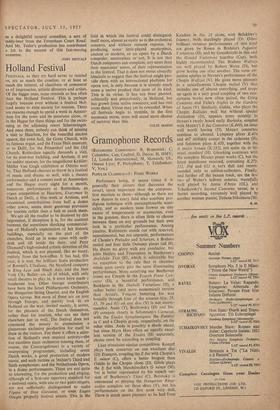Gramophone Records
(RECORDING COMPANIES: B, Brunswick; C, Columbia; Cap, Capitol; D, Decca; H, HMV;
London Internatiotal; M, Monarch; OL, Oiseau Lyre; P, Parlophone; T, Telefunken; V, Vox.)
POPULAR CLASSICS-1 PIANO WORKS
Performers being, it seems (since it is generally thcir picture that decorates the cover), more important than the composer, first mention to them—although as there are now dozens in every field who combine pro- digious technique with unexceptionable musi- cality, and as modern taste frowns on any excess of temperament or mannerism, even in the greatest, there is often little to choose between them on any grounds but their own luck in a particular performance. Among pianists, Rubinstein stands out with reserved, unsentimental, but not unpoetic, performances of Chopin's Preludes and Scherzos, a Brahms recital and four little Debussy pieces (all H). He shares no glory with any conductor, but joins Heifetz and Feuermann in Beethoven's Archduke Trio (H), which is admirable but no exception to the rule that in chamber music stars rarely give the most illuminating perforthances. More satisfying star Beethoven issues are Curzon in the Fourth Piano Con- certo (D), a beautiful performance, and Backhaus in the Diahelli Variations (D), a rather better (and more economical) version than Arran's. Frugoni battering his way brutally through four of the sonatas (Op. 28. 53, 79 and 81) on one disc (V) is not recom- mended. Anda (1'), Brailowsky (H) and Siki (1)) compete closely in Schumann's Carnaval, with the Etudes Symphoniques, the Fantasy in C and a Chopin group, respectively, on the other sides. Anda is possibly a shade ahead, but since Myra Hess offers an equally excel- lent version of the Etudes (H) soparately, choice must be according to coupling.
Liszt stimulates similar competition. Kempff plays both concertos on one excellent disc (D), Francois, coupling the E flat with Chopin's E minor (C), offers a better bargain than Gulda in the Chopin alone (p). Gilels plays the E flat with Mendelssohn's G minor (M), but is better represented by his superb ver- sion of Beethoven's Third (C). Borov.sky is announced as playing the Hungarian Rhap- sodies complete on three discs (V), but his performances on the first seem very dull. There is much more pleasure to be had from Katchen in No. 12 alone, with Balakirev's Islamey, both dazzlingly played (D). Other brilliant virtuoso performances .of this kind are given by Rosen in Brahms's Paganini Variations (D), and by Gorodnitzki in this and the Handel Variations together (Cap), both highly recommended. The Brahms Walizev arc well played by Robert Weisz (D), but grow boring one after another. The same ob- jection applies to Novaes's performance of the Chopin Waltzes (V). He gives more pleasure in a miscellaneous Chopin recital (V) that includes one of almost everything, and crops up again in a yery good coupling of two con- certante works now often paired, the Grieg Concerto and Falla's Nights in the Gardens of Spain (V). Similarly, Gulda, who plays the Chopin Ballades well but without special distinction (D), appears more notably in Strauss's rarely heard early Burleske, coupled with Mozart's E fiat Concerto (K.449), an issue well worth having (D). Mozart concertos continue to abound. Lympany plays K.414 and 467 stylishly except in the cadenzas (H), and Solomon plays K.450, together with the A major Sonata (K.331), not quite up twins usual standard (H.). Gieseking continues with the complete Mozart piano works (C), but the latest instalment received, containing K.279. 311, 394 and 613 is, very dull and recom- mended only to edition-collectors. Finally, and further off the beaten track, are the first two of Weber's tedious sonatas, wastefully well played by Annie d'Arco (OL), and Tchaikovsky's Second Concerto, uncut, in a Soviet recording, extremely well played by another woman pianist, Tatiana Nikoleeva (M).


































 Previous page
Previous page